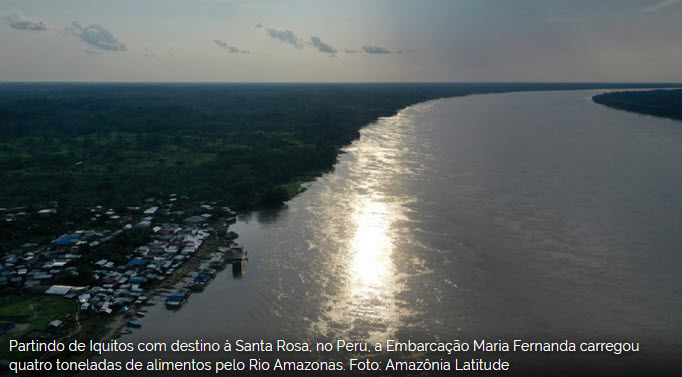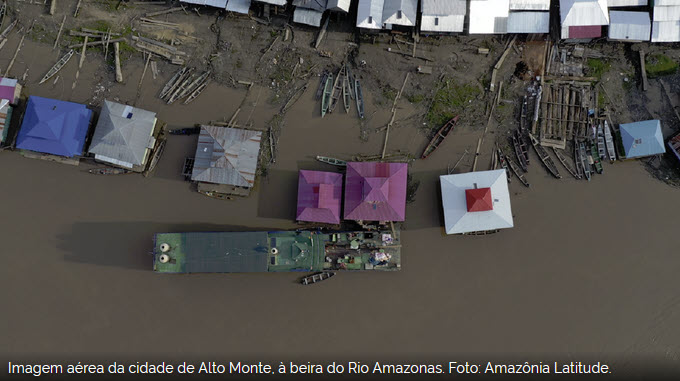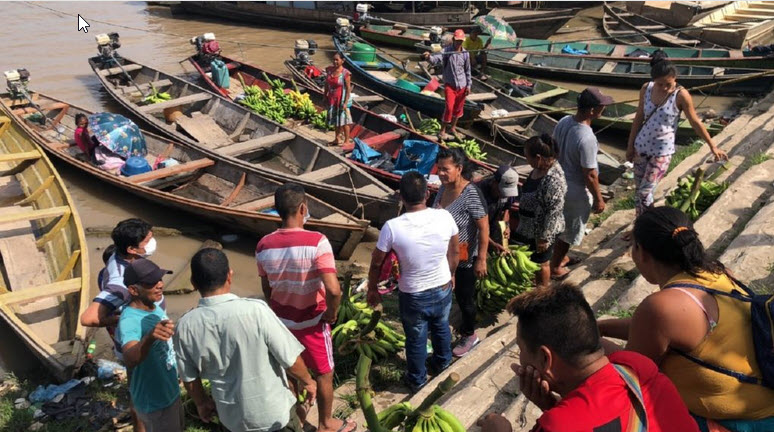This article originally appeared in Portuguese in the Portuguese newspaper O Público, on 2 April, here.
The version published by Amazon Latitude, here, was translated for LAB by Theodora Bradford
I will never forget the conversation I had two days ago with Rafael, a fisherman from the banks of the River Solimões, in the small and isolated town of Tabatinga, Brazil. His words still haunt me: ‘In the Amazon, if COVID-19 doesn’t kill people, hunger will’.
Reaching the ‘heart’ of the Amazon
It is less than 24 hours since I arrived home from what I consider to be the ecological heart, the very soul of the planet, the Amazon. I left Tallahassee, Florida, on 12 March for a research trip to Iquitos, Peru. When I left Florida coronavirus was already making headlines around the world, but I decided to go, cautiously, as I would otherwise have lost all the money I had saved up for the trip. My goal was to finish the documentary I was making about environmental issues in the Amazon with several local poets. However, a great turn of events took me by surprise and forced me into situations that allowed me to get a clearer picture of the challenge we face as a species.
Before the situation surrounding COVID-19 escalated, I was able to visit several riverine communities around Iquitos and experience the bustle of the former Peruvian rubber capital’s famous Belén market.
But on Sunday 15 March, at around 8pm, the President of Peru, Martin Vizcarra, declared a state of emergency and shut all borders. He gave tourists less than 24 hours to leave the country. Many foreigners were unable to find a way out and are still stranded there, without the slightest idea of when they may be given permission to leave.
On Monday 16 March I tried to catch a flight to the small Peruvian town of Caballococha, in order to continue my journey onward from there to Tabatinga, Brazil, by boat. Bruno Erlan, a Brazilian cameraman, and I (my father being from the U.S. and my mother Brazilian) arrived at the airport ahead of time with pre-booked tickets. Unfortunately, due to poor weather, the flight was cancelled.
In the airport we were told that there was a boat scheduled to leave for Tabatinga at 7pm. We ran to the pier through the chaotic streets of Iquitos. The main roads were closed by the local police and the traffic was even more manic than usual. We arrived at the pier before 7pm, but the boat was already full. There were more than 600 people crammed into a boat with a capacity of perhaps 300.
I decided to stay in Iquitos and, because of my Brazilian passport, contacted the Brazilian Consulate in the city. They managed to negotiate our departure with the local authorities. We were to embark on a cargo boat headed for the town of Tabatinga, situated near Brazil’s border with Colombia and Peru.
On Wednesday 18 March, three days later, we went to the Brazilian Consulate in Iquitos for a medical check-up before leaving the country. Four doctors from Peru arrived in an ambulance equipped to carry out several tests on our group (consisting of a total of eight Brazilians). When this was done, the staff from the consulate escorted us to the cargo boat.
Food supply by boat
We spent three whole days travelling through the lower Amazon. The boat (a private initiative) was loaded with four tonnes of food supplies which were to be distributed to villages along the way. We stopped in the small ‘towns’ of Pebas, Nuevo Pebas, Cochiquinas, Alto Monte, San Isidro, San Pablo, Caballococha and Santa Rosa. The Bora, Huitoto, Tikuna and other ethnic groups inhabit these riverine communities. In all of them, I was able to witness an Amazon that had previously been invisible to me.

I could not help but notice, during all of these stops, how these Amazonian villages had changed and how these changes were affecting their livelihoods, culture, way of life and interactions. The communities had become almost entirely dependent on supplies which arrived via cargo boat, like the one I was travelling in. The boat provided everything, from rice, beans, flour, eggs, water, soft drinks and all kinds of fruits and vegetables to building materials, tiles, furniture, clothes, etc.

The cargo boat is greeted by the riverine communities as an abundant supply of everything that the forest can no longer give them. One of the captains said to me: ‘I’ve been doing this for 30 years and these villages aren’t what they used to be. Now you see the river, but that’s it; there aren’t any fish.’ He continued: ‘People here don’t like farming anymore; they are increasingly dependent on the cargo boat.’
Seasonality and migration
In the face of the current coronavirus pandemic, traditional Amazonian populations demand special attention. It is well known that there are seasonal shortages of regional staples from the land. Products like eggs, turtles, watermelons and beach beans do better when the waters recede. International migration of political refugees and those fleeing catastrophes alters traditional riverine relations with the introduction of other nutritional needs and eating habits. The displacement of landless peoples from the South and Southwest to the Amazon reinforces this change: these populations do not know how to plant and harvest crops in the forest unless it has previously been cleared and burned.
Seasonality changes the demographic profile of the local population, causing migration from settlements. Furthermore, the situation of refugees, from both Venezuela and Haiti, and of displaced populations from various parts of the Amazon, is aggravated by COVID-19. Changes in the way of life of traditional populations have made them dependent on goods from the big cities, which arrive in weekly shipments to communities via the river, meaning that the imposition of controls on movement could be catastrophic.
Market relations in the deep Amazon, a region with little external influence, explain the dependence on external goods. These relations restrict riverine communities’ traditional hunting, gathering and production activities to family agriculture for the benefit of agronomists. The population of the Amazon is growing exponentially, so how can production meet supply needs? How can the provision of basic necessities be reinvented without harm to the environment? This is the age-old question at the heart of the problem.
Riverine communities of the upper Amazon depend on access to supply boats because they are unable to produce their own food. Moreover, they do not have access to land ownership nor the means for productive agriculture and therefore do not use paper money. Only the most isolated Indian fishing communities are able to maintain their subsistence way of life. The practice of gathering food has also been affected by controls on land use.
The untouchability of nature
The traditional method of preparing the land, slash and burn, is prohibited. The ban is the result of apparently naïve environmental legislation. To put it simply, external environmentalists defend the untouchability of nature and advocate for the depopulation of the region for its preservation. This has been a recurring debate among ‘multilateral’ groups since 1992. Outsiders claim that the traditional technique of burning and clearing the land for planting crops is damaging to the environment. Many environmentalist arguments maintain that burning produces excess heat and this has been seen recently during the Amazon summer. Hunting, which is seasonal, is also impossible in the period between harvests, due to flooding. Current prohibition laws in Brazil are in place on a municipal, state and federal level. Any fish that are caught are not worth selling and are salted and kept for the off-season. The value of fish is determined by commercial relations between businessmen in the fish industry and does not involve the fishermen themselves.
All this has an impact on land use changes, as riverine peoples and Indians depart from traditional customs and local food staples to cultivate things that they do not usually eat. The expansion of oil crops, grown for export in the south of Amazonas, Humaitá and Porto Velho, is an example of this. Such practices have become increasingly common in the Amazon.
As a result, the acquisition of new food products, primarily chicken, pasta, beans, dried salted meat and rice, leads to dependence on wholesale and retail trade, in addition to increased boat traffic. River-dwellers buy these goods in exchange for rare seasonal fruits, fresh and salted fish and even game. This ‘system’ of dependence actually has a long history, at least as old as the rubber trade, which today has been substituted by logging and other forms of extractivism. Dependence is nothing new, but it is increasing with the availability of more goods and regular supply. In other words, traditional activities are replaced with market relations, no longer dependent on nature but on trade routes.
The indigenous peoples of the Amazon are endowed with extraordinary knowledge that is invaluable to humanity. Now more than ever, we must listen to them and preserve their cultural and ecological values to guarantee their survival and, consequently, the survival of the Amazon. Otherwise, the colonisation and dispossession of ancient customs will continue, with the spectre of COVID-19 only serving to accelerate the process.
Dr Marcos Colón coordinates the Portuguese programme at the Department of Modern Languages and Linguistics of Florida State University. He is also the writer, director and producer of ‘Beyond Fordlândia: An Environmental Account of Henry Ford’s Adventure in the Amazon’

